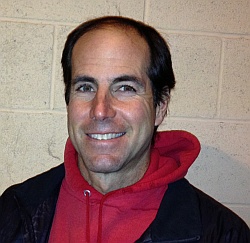Today’s ‘Interview with an Author’ is with Dr. Grant Harris, the corresponding author on “Sampling designs matching species biology produce accurate and affordable abundance indices” which we published last month.

Dr. Grant Harris is Chief of Biological Sciences for the southwest region of the United States Fish and Wildlife Service (USFWS). For his work, he uses ecological and statistical approaches to unravel species use of the landscape, and/or estimate population sizes and trends. His work is applied, and used to identify priority areas for conservation and to improve the management and conservation of animals and habitats.
PJ: Tell us a bit about the research you published with us, and what is the take-home message of your article?
GH: Take home: Sampling animals at places that attract them (locations with food, water, etc.) can provide accurate and scientifically defensible indexes of abundance (i.e. population size), as long as all (or most) individuals visit those places.
Relevance: Look at the IUCN red list that evaluates the conservation status of animals (and plants). Many threatened animals lack abundance data. This happens because the methods to acquire abundance must be scientifically defensible for the results to be credible, and doing so for animals that are sparsely distributed or living in remote places (i.e. many threatened species) often makes projects logistically challenging and unaffordable. This same dilemma exists for other non-threatened species sharing similar characteristics. Biologists and conservationists need approaches to address this problem.
What we did: We compared the performance of an established technique – sampling in grids – to sampling only at places that attract the target animal (targeted sampling). We found that both techniques provided abundance indices, because not all individuals were available for sampling. Targeted and grid sampling had equal accuracy, while targeted sampling was more precise. Since targeted sampling focuses on places of biological importance where most individuals go, this eases logistics and reduces costs, making the approach more affordable.
PJ: What challenges did you face while doing this research?
GH: Immobilizing brown bears and putting collars on them is stressful and risky work.
We’ve also met some resistance over worry that targeted sampling could encourage projects to overlook statistical rigor, while the drawbacks we reported for grid sampling could erode confidence in this technique. For the first point, we’re adamant that sampling techniques must be statistically sound to provide defensible results, irrespective of the approach. Targeted and grid sampling can do this, provided the underlying assumptions are met. For the second point, we need to understand the drawbacks with any sampling design, to ensure the work we do is sensible and that project results are interpreted properly.
PJ: Did you find anything surprising or unexpected while conducting your research?
GH: The amount of imprecision with grid sampling surprised us.
PJ: Where do you hope to go from here? What is next in your research?
GH: We are evaluating targeted sampling in the field, to acquire abundance data for other species, like bighorn sheep. If the approach provides acceptable results, it will assist with evaluating sheep trends in the southwestern USA, while perhaps increasing opportunities for indexing abundance of endangered Caprinae elsewhere.
PJ: As a PeerJ Author, how would you describe your overall experience with us, in terms of submission, review, and production?
GH: The process paralleled experiences with other scientific journals. However, there were three major differences with PeerJ: streamlined submission (easy and intuitive), rapid turnaround, and affordable publication costs.
PJ: PeerJ encourages Authors to make their review comments visible. Why did you choose to reproduce the complete peer-review history of your article?
GH: Science is all about transparency and accountability. Further, asking reviewers to identify themselves is likely to improve the review and make it more constructive.
PJ: What do you think about our “Pay once, Publish for life” publishing plan?
GH: I hope it works long term!
PJ: What are the advantages for you to publish with us? What do you feel makes PeerJ relevant to scientists?
GH: Federal Agencies within the United States have policy describing that science funded with public money be published so results are freely available to the public. The ability to submit articles to PeerJ for review and potential publication, affordably, could play a large role. I work with a dozen scientists, and with current publishing rates spanning 1.5 – 3K (open access), publishing gets expensive, quickly.
PJ: Anything else you would like to talk about?
GH: We encourage scientists and students to ask questions about our work and related efforts. Without challenging questions, science won’t progress.
A major impetus for doing this work was presenting a sampling design that could provide abundance data for rare and elusive species, when standard techniques are difficult and expensive to implement. We will continue working toward this objective. If others are too, we’d welcome sharing ideas.
PJ: Many thanks for your time!
Dont forget that from now until end-March 2014, we are running a special offer for free PeerJ Publications.

